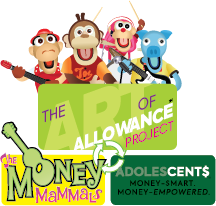
“Working to help parents raise money-smart kids.”
Hello!
Welcome again to 3 Ideas to Share and Save.
It’s acceptance season! Colleges are making their decisions, and my high school senior is gripped with an awful anxiety that won’t end until she chooses where she’ll go next year.
When I applied to college, you knew whether or not you were accepted before you even opened the mail.
Small letter = rejection ????
Big, fat package = acceptance ????
Today’s emailed ???? and ???? feel strange. Electronic rejections seem harsher, and digital acceptances seem hollower. Of course, perhaps this is just my perception of the process. My daughter doesn’t know the difference.
One undeniable distinction, though, is that the price we will pay for college is much, much higher.
— 1 —
This is why I’m so excited to share with you my first Art of Allowance podcast conversation of 2021. Ron Lieber, the “Your Money” columnist for The New York Times and the author of a new book, The Price You Pay for College: An Entirely New Roadmap for the Biggest Financial Decision Your Family Will Ever Make, joined me for a chat about how we can help our kids find as valuable a college experience as possible.
Our wide-ranging discussion covered many topics, including:
- Three things students are looking for in a college
- How to talk about money with your college-bound kids
- Strategies to help parents of children of all ages begin saving for college
Our family made it a point to visit colleges whenever we traveled. We’re glad we did, as the pandemic largely eliminated college tours. And although we almost always incorporated a price discussion during our visits, we discovered how easy it is for kids to fall in love with places that are, not surprisingly, budget-busters.
In retrospect, we might have limited our visits to out-of-budget schools. The problem, which I discussed with Ron, is the lack of transparency about how aid, merit-based in particular, is distributed. This makes it hard to determine which schools actually are beyond your budget.
— 2 —
I’ve been thinking a lot lately about a concept that I like to call “reasonable consumerism.” You’ve probably heard the oft-quoted phrase, “Personal finance is personal.” Award-winning financial literacy educator Tabitha Thurman and I discussed it on the podcast.
According to Investopedia, consumerism is “the idea that increasing consumption of goods and services purchased in the market is always a desirable goal and that a person’s wellbeing and happiness depend fundamentally on obtaining consumer goods and material possessions.”
Consumerism drives markets. Part of becoming money-empowered is finding a sweet spot on what I think of as the “reasonable consumerism slider.” In practical terms, I tell my kids that they don’t need to be as minimalist as I am; however, they probably want to orient their sliders more towards the left than the right. I thought the visual below might make that point better. (BTW…I sometimes refer to outrageous consumption as Kardashianism.) I’d love to know if you and your kids find this helpful.
— 3 —
Since we’re on the subject of consumerism, I stumbled upon this helpful infographic while doing some research. I searched for a newer version, but I couldn’t find a better one.
I like resources like this. I’ve made a monthly reminder to look at this graphic just like the reminder I’ve created to review this household calendar PDF, which I scanned from a 2006 issue of Money.
I hope you find one or more of these ideas useful in some small way.
Until next time, I wish you and your family well on your own money-smart journey.
John
